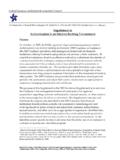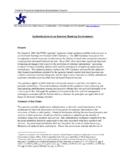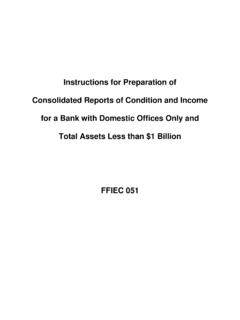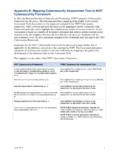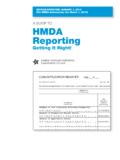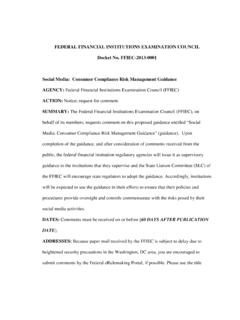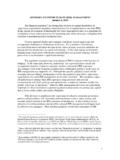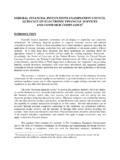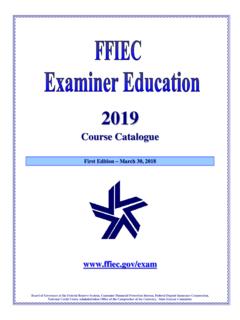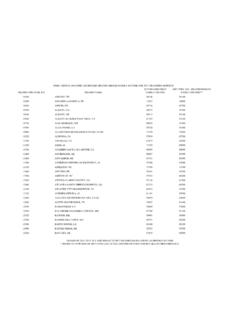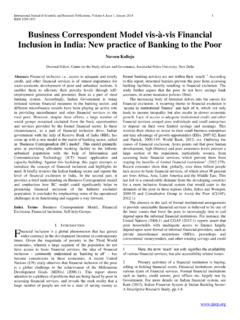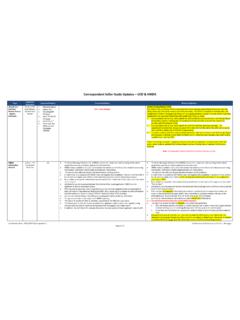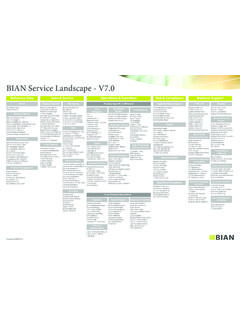Transcription of Check 21 Presentations - FFIEC Home Page
1 Page 1. Check 21 Presentations 1. Check Clearing for the 21st Century Act Examiner and Industry Check 21 Compliance Training 2. Module 1: Overview of Act and Final Regulation Overview of Act and Final Regulation 3. Just as in other areas of business , technology is changing Technological Changes how the financial industry conducts business . The emer- gence of ATMs and Internet transactions are just two of the many ways that institutions now use technology to decrease operational expenses and stay competitive. 4. Industry wide, there are now about 40 billion Check trans- Check Imaging actions a year.
2 Another technology used to cut costs and reduce risk is Check imaging, or electronic Check ex- change replacing the labor-intensive process of sorting, transporting, presenting, and reconciling paper checks with a faster and potentially less error-prone process. While some financial institutions have rapidly migrated toward electronic Check exchange, others are proceeding more gradually. Page 2. 5. In addition to the emergence of Check imaging, over the General Decline In Paper Checks past few years there has been a nation-wide decline in the Shift from checks to total volume of checks being written.
3 This is because electronic payments consumers and businesses: More electronic payment Have shifted from paper checks to electronic payments options methods such as debit cards and Internet transactions ACH conversions Increasingly used electronic payment options, such as Internet and ACH transactions for payment. As a result of these conditions, a situation evolved in which institutions that wanted to engage in electronic Check exchange on a widespread basis were hampered in their ability to do so by institutions that were not yet ready to move forward with the technology.
4 6. Specifically, barriers to electronic Check exchange included: Barriers The need to establish formal agreements to collect or Need for formal agreements return checks electronically, which required an unmanage- among institutions able number of agreements among hundreds of institu- Expense and complexity of tions, and agreements Continued insistence by some banks on receiving paper Resistance to accept Check checks, which was slowing down the transition from paper- imaging based to image-based Check processing. 7. Because exchanging Check images provides so many Request For Assistance advantages over using paper checks, financial institutions and consumer groups worked with the Federal Reserve, and later with Congress, to develop a legal framework that would help foster electronic Check exchange without penalizing institutions that were not yet ready to move into the exchange of electronic images.
5 8. The result was the Check Clearing for the 21st Century Check 21 Act Act, which passed on October 28, 2003 to take effect Passed October 28, 2003 October 28, 2004. Effective October 28, 2004. Page 3. 9. The law is designed to foster the transition from paper- Check 21 Act based to image-based processing a transition that is expected to accelerate over the next few years, as banks and consumers gain experience and confidence in the new paperless process. 10. Generally referred to as the Check 21 Act or Check 21, the Check 21 Act legislation: Facilitates image processing Facilitates the use of imaging for Check processing.
6 Fosters innovation in Fosters innovation in the Check collection system; and collection systems Improves the overall efficiency of the nation's payments Improves overall payment system. system efficiency Does not require electronic The legislation does not require any individual institution Check process to change its current Check -processing methods or to process checks electronically, unless or until it determines electronic processing is advantageous to its particular business operation. 11. On July 26, 2004, the Board of Governors of the Federal Final Rule Reserve System released its final rule amending July 26, 2004 Regulation CC, Availability of Funds and Collection of Checks, to implement the Check 21 Act.
7 A new subpart D. Regulation CC. was added that details the requirements of the Check 21. Subpart D Act that apply to banks, provides a model consumer Requirements Model Awareness Disclosure awareness disclosure and other model notices for Model Notices educating consumer customers about their rights under Indorsement and identification the Act, and specifies bank indorsement and identification requirements for substitute requirements for substitute checks. checks 12. The primary purpose of the legislation was to facilitate Substitute Check electronic Check exchange by authorizing a new negotia- ble instrument called a "substitute Check .
8 ". Front Substitute checks facilitate electronic Check exchange by enabling a bank to create a substitute Check for present- ment to banks with which it has no pre-existing agreement to exchange electronic images. Back Specifically, the regulation defines a "substitute Check " as a paper reproduction of the original Check that contains an image of the front and back of the original. Since substi- tute checks are checks, they are subject to existing Check law. Page 4. 13. In addition, the substitute Check must: SUBSTITUTE Check . Bear a MICR line containing all the information from the Bear standard MICR line, per original Check 's MICR line, except as provided in ANS.
9 ANS to facilitate the processing of substitute Conform with ANS checks;. 140 standard for substitute Conform in paper stock, dimension, and otherwise with the checks industry standard for substitute checks; and Be suitable for automated Be suitable for automated processing, just like the original processing Check . 14. The regulation provides that a properly prepared substitute Legal Equivalent Check is the legal equivalent of the original Check if it: All front and back information Accurately represents all of the information on the front on original Check : and back of the original Check , including payment, identifi- Payment cation, and indorsement information.
10 Identification Indorsement information Bears the Check 21 Act's required legal equivalence Legal equivalence legend legend that reads, This is a legal copy of your Check . You Bank warranties can use it the same way you would use the original Check . ; and Has been warranted by a bank, according to the Check 21. Act warranty requirements with respect to the substitute Check . A legally equivalent substitute Check can be used in place of an original Check , wherever the original Check is re- quired. 15. The interdependent nature of the payments system virtu- Payments System ally guarantees that every financial institution will at least receive substitute checks.
